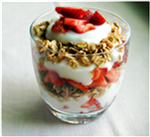Kaci Adams, MS, RD, LDN
Did you know that May is National Osteoporosis month?
Osteoporosis, is a disease in which the body gradually loses bone, makes too little bone, or both occur leading to weakened bones and an increased risk of fractures.
Osteoporosis is very common. It is estimated that roughly 54 million Americans have or are at risk of developing osteoporosis, with women being at a greater risk than men. In fact, 1 in 2 women and 1 in 4 men aged 50 years or older are at risk of an osteoporotic fracture. Osteoporosis is a serious and costly disease resulting in 2 million broken bones and costing $19 billion in healthcare cost per year. By 2025, experts predict that osteoporosis will be responsible for approximately 3 million fractures and $25.3 billion in healthcare costs annually. The most common fractures associated with osteoporosis occur at the hip, spine and wrist.
Fear not, you can lower your risk of developing osteoporosis by maintaining a healthy diet and weight, and through adequate physical activity. Ninety percent of adult bone mass is created by the end of adolescence; therefore, preventative measures should start early on in childhood and continue throughout adulthood. But before we dig deeper into preventative measures, let’s first take a look at the physiology of bone development.
Your bones are constantly changing as osteoblast work to form bones and osteoclast break down old bone. Bone formation exceeds bone breakdown during times of growth such as childhood, adolescence, and early adulthood. Breakdown starts to exceed formation in aging adults, especially in postmenopausal women.
Calcium and Vitamin D are crucial nutrients in preventing osteoporosis. . Calcium is not produced in our bodies, making it an essential nutrient that must be obtained from the diet. Ninety-nine percent of calcium is stored in bones and teeth, and when we do not consume a sufficient amount to maintain bodily functions (such as cell signaling and muscle contraction), it is taken from our bones causing them to breakdown. Unfortunately, 85% of girls aged 9-13yo (the time when 40% of bone mass develops) are not consuming the recommended amount of daily calcium. Food sources of calcium include dairy products such as reduced-fat milk, yogurt, and cheese; green vegetables; and calcium-fortified foods such as soymilk, tofu, cereals, snacks, breads, and orange juice.
Vitamin D is essential for calcium absorption in the gut, for maintaining adequate serum calcium and phosphate levels for bone development, and bone rebuilding by osteoblasts and osteoclasts. In order to synthesize vitamin D your skin must be exposed to ultraviolet light, typically from the sun. However, most Americans protect themselves from ultra-violet rays with sunscreen, which limits vitamin D absorption, and those living at higher latitudes may not receive enough direct sunlight to synthesize vitamin D year round. Furthermore, those with dark skin do not produce vitamin D as efficiently. Therefore, it is important to consume vitamin D from food sources as well. Food sources of Vitamin D include fatty fish such as salmon, tuna, and mackerel and fish liver oils; fortified foods such as milk, milk products, orange juice, and cereals; beef liver; cheese; and egg yolks.
2015 Dietary Guidelines | |||||||
| Age | 1-3yo | 4-8yo | 9-18yo | 19-50yo | Men 51+70 | Women 51+yo | 71+yo |
| Calcium | 700mg | 1,000mg | 1300mg | 1,000mg | 1,000mg | 1,200mg | 1,200mg |
| Vitamin D | 600IU | 600IU | 600IU | 600IU | 600IU | 600IU | 600IU |
Other nutrients that have been shown in research to support bone health include vitamin K (dark green leafy vegetables, broccoli, Brussels sprouts, cabbage, cauliflower), vitamin C (citrus fruits, tomatoes, broccoli, sweet potatoes), and magnesium (green spinach, legumes, nuts, whole grains); however, more research is needed to confirm their role in preventing osteoporosis.
Weight-bearing and muscle-strengthening exercises are important for building and maintaining bone density. Examples of weight-bearing exercises include: dancing, aerobics, hiking, jogging/running, walking, jumping rope, stair climbing, tennis, and elliptical trainer. Muscle-strengthening exercises include: weight lifting, exercise bands, weight machines, and calisthenics (own body weight).
Other Tips:
- Avoid smoking.
- Limit alcohol to 1-2 drinks a day.
- Limit caffeine as it can interfere with calcium absorption and lead to bone loss.
- Limit dark soft drink (including diet) consumption as the high levels of phosphorus in these beverages may contribute to bone loss.
- Maintain a healthy weight as excess fat cells cause inflammation, which can lead to bone damage.
Bottom line: Maintaining a healthy lifestyle that incorporates low-fat dairy products, fatty fish, fortified whole grains, citrus fruits, vegetables (especially dark green leafy vegetables and tomatoes), nuts, and legumes; includes regular physical activity; and limits smoking, alcohol and caffeine is your recipe for success in osteoporosis prevention. And remember, it is never too early to start your fight against osteoporosis as healthy bone formation is most critical during childhood and adolescent years.
Yogurt parfaits are a healthy way to boost your or your child’s bones’ health at the beginning of the day!
Ingredients:
- 6oz plain, Greek yogurt
- 3 strawberries sliced
- 4 walnut halves or 6 almonds
- ½ cup fortified cereal such as Multigrain Cheerios, All Bran, Rice Krispies, or Special K
Directions: Layer Greek yogurt with strawberry slices, nuts, and cereal in a glass or bowl. Pair with 4oz 100% fortified orange juice.
Nutrition Formation:
Calories: 300 cal, Protein: 21 g, Carbohydrates: 35 g, Fat: 9 g, Calcium: 272 mg (27%), Vitamin D: 20 IU (5%), Vitamin C: 102 mg (107%), Magnesium: 62mg (16%), Vitamin K: 1.4 mcg (1%)
References:
- https://www.nof.org/patients/what-is-osteoporosis/
- http://www.todaysdietitian.com/newarchives/021313p44.shtml
- http://health.gov/dietaryguidelines/2015/guidelines/appendix-7/

